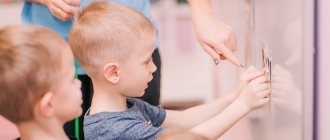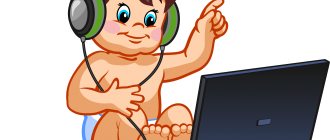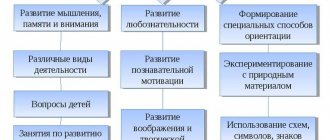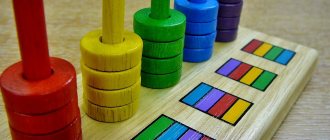Development of cognitive activity of preschool children
The youngest age of children - up to 5 years inclusive - is usually divided into 2 groups: the infant period and the preschool period. The first lasts from 0 to 3 years, and the second from 3 to 5.
As a rule, most schools and existing methods for developing the cognitive activity of preschoolers are designed specifically for this age period.
The study of child development differs significantly from research programs studying the activities of adolescents and adults. This can be clearly seen in the way the work is carried out and the methods of its implementation.
The main principle followed by the inventors of diagnostic programs is the principle of naturalness. It implies minimal interference from elders in the child’s everyday life.
Most often, a child’s cognitive activity is provoked in a playful way, which takes into account age-related developmental characteristics.
Various development scales are very popular and convenient to use, which provide for analytical and statistical observations with subsequent recording and comparison of activity data with age norms.
Working with scales requires specialized experience and should only be carried out under the supervision of seniors and a specialized psychologist. Therein lies a significant difficulty, because in the presence of a stranger, it is difficult for a child to show natural reactions to a stimulus. In this case, it is necessary to introduce active interaction between the teacher and psychologist.
The development of cognitive activity of preschoolers is a key direction in the education of preschoolers.
Boys are more likely to be active and learn about the world in the process. They can spend hours watching the operation of an excavator, a garbage disposal, or look into the driver's cab.
For them, the most relevant will be the stimulation of cognitive activity in the form of a live game. Only in this case will the knowledge be fully perceived and form the basis of the “imaginative” luggage. Girls are calmer and more persevering. For them, the “mother-daughter” game will be much more informative, which will gradually lay down the necessary knowledge for adult life. An art studio or music school will help develop a sense of beauty and give you a sense of self-worth.
Cognitive activity is in the blood of every child and is designed to help him adapt to life in the adult world. Gradually it transforms into a desire for knowledge and manifests itself in search games. The child will strive to gain new knowledge about the lives of older people and fresh impressions. With age, activity will develop into curiosity, which is so characteristic of the older generation.
In the early period of development, the emergence of a primary idea of the surrounding world occurs.
To form an image, all available means are used, which are inextricably linked:
- cognitive activity - perception of the world, thinking, imagination, memory, attention;
- emotional coloring - personal reaction to current events, surrounding objects and phenomena;
- the information obtained during the search process is knowledge and experience, both personal and of the older generation.
The child’s cognitive development is stimulated by a harmonious combination of the above stages. Educators and parents should help with this, not forgetting that a child’s cognitive process is fundamentally different from an adult’s.
An accomplished person perceives the surrounding reality from the point of view of the mind, and children - emotionally.
If for the former, facts are primary, and relationships and emotions are secondary, then for preschoolers the situation is exactly the opposite.
Correct formation of the development of adult thinking includes:
- knowledge - there are many secrets in the world that need to be revealed;
- frugality - the world is tender and fragile, it requires care and protection;
- creation - the world is beautiful and I want to pass it on and multiply it.
When planning cognitive development, you should remember the age-related characteristics of the child’s development.
The activity of a 3-year-old preschooler is based on a simple principle: I look, I act, I manipulate. This is how he experiences the world: he examines objects from all sides, tries, throws, feels.
With the help of simple actions, the child seeks answers to the basic questions “what, why, and why.” However, a 3-year-old preschooler cannot comprehend the hidden characteristics of an object on his own.
At the same time, children begin to draw the first parallels and cause-and-effect relationships, to perceive the meaning of the object and its role.
At the age of 3, it is best to direct cognitive activity in the direction of knowledge: organize interesting excursions and walks (in the garden, yard or small square), introduce them to pets, plants, and inhabitants of the aquarium.
Children of this age group love to receive gifts from nature: autumn leaves, sun rays, prickly snowflakes, pine cones, chestnuts.
It is very useful to hold informative celebrations - soap bubbles, paper crafts, flying seeds, butterfly wrappers.
This is where a respectful attitude towards the people around us and the “correct-help” connection is laid.
Cognitive activity is carried out all the time in one form or another, and not just in class, because is of enormous importance in the harmonious development of the child’s personality.
Individual conversations or group games, observing the world around us, solving riddles or simple puzzles, daily care for pets or a green corner - this is an incomplete list of educational activities.
By the age of 4, the body matures: physiological processes that change the cerebral cortex are activated, the nervous system is improved, the vocabulary and stock of impressions about the surrounding reality increase. During this period, the baby’s cognitive activity undergoes changes and moves to the next stage of development.
The child’s activities at this time are aimed at the path of discovery and accumulation of knowledge. The preschooler correctly perceives the information received verbally and learns to analyze it. This is what allows you to increase your child’s social circle and stop limiting yourself only to your close circle.
At the age of 5, a preschooler clearly and clearly perceives the surrounding reality, the store of knowledge and experience of previous years helps him in this. The main task of the adult generation during this period is to organize a subject-development environment to enhance cognitive activity.
Ways of understanding the world: verbal, auditory, kinetic, visual. Cognitive activity is aimed at obtaining new information; there is a desire to constantly expand horizons and look for additional sources of knowledge.
The degree of mental and intellectual development allows one to begin to become familiar with the categories “symbol, time, category.” Informative conversations, discussions of life situations, watched cartoons and videos, timely and correct answers to questions asked are welcome.
By the end of the “preschooler” age period, adults and educators should focus on organizing information according to any criterion, encouraging cognitive activity in the field of forming a positive picture about the world around them according to thematic blocks and areas of knowledge, and establishing cause-and-effect relationships.
In the preschool period, parents are faced with the question of determining their child’s abilities.
From a very young age, you can trace a child’s attraction to something, just watch him carefully - some dance, some draw, and some love to make things.
If you notice the preferences of a young person in time and take steps to develop abilities, then in adulthood you can get real talent.
The problem of correctly determining a child’s preferences arises quite acutely, because Not all parents are able to truthfully assess the achievements of their own child and often exaggerate them.
Educators and teachers of thematic circles, sections and studios can help with this. Sometimes a child can try them all until he finds the best leisure option for himself.
With proper development and a favorable environment, preschoolers grow into tireless optimists, inquisitive researchers, dreamers and thinkers. Help your children, guide their cognitive activity along the right path!
Children's experimentation
Sometimes another type of child’s thinking is identified - child experimentation. It represents the unity of visual-effective and visual-figurative thinking, and is aimed at knowing the properties and connections of objects.
Such thinking takes the form of experimenting with a phenomenon: the child causes or stops the phenomenon, changes it in one direction or another. In the process of such actions, the child receives new, sometimes unexpected information, which often leads to a change in ideas about the object. For example, a child puts a wooden boat in a stream and sees how it floats, then he takes his toy boat made of iron and sees how it goes to the bottom. The child is perplexed, because both toys are boats that should float, but one drowned. Then the child comes to the conclusion that not every boat is capable of sailing and begins to investigate this issue. In this experimentation, the moment of self-development is clearly presented: the use and transformation of an object/phenomenon reveals its new properties to the child, which, in turn, allow them to make guesses and bring them to life.
Experimentation encourages a child's curiosity and initiative, independence, flexibility of thinking, courage, and stimulates the search for new solutions and creativity. Independent experimentation gives the child the opportunity to try different ways of doing things, while removing the fear of making a mistake (since there is no right option). The ability to be surprised by new things, to make your own guesses, to ask yourself and others questions is more important in the development of thinking than the reproduction of ready-made patterns of action and the assimilation of knowledge given by adults. The role of an adult in this process comes down to creating special objects and situations that stimulate cognitive activity and experimentation.
Phenomena of children's thinking by J. Piaget
At first, a child’s thinking is extremely imperfect and its main feature is egocentrism - when the child evaluates any situation only from his own position (point of view). What the child perceives seems to him to be the absolute and only possible option. The reason for this is insufficient separation between the Self and external reality.
An excellent example of egocentrism is the well-known test about brothers, where an adult asks a child:
- You have brothers? - Arthur. - Does he have a brother? - No. – How many brothers do you have in your family? - Two. - How many brothers do you have? - One. - Does he have brothers? - No, absolutely not.
The child does not realize that he may not be the “central” object, and therefore does not realize that his brother has brothers.
Jean Piaget identified other phenomena of children's thinking, which are based on egocentrism:
Animism is the attribution of animation to inanimate objects. Piaget reports the following conversation with a boy:
– Is the sun alive? - Alive. - Why? - It gives light. – Is the candle alive? – Alive, because it gives light. She is alive when she gives light, but not alive when she does not give it.
Artificialism is the understanding of natural phenomena by analogy with human activity or as created by man.
– What does the sun do when there are clouds and rain? – It is leaving due to bad weather. - Why? - Because it doesn't want to get caught in the rain.
Realism is the tendency to consider objects as they appear in their immediate perception. When the moon follows a child while walking, that means it is so. Or a three-year-old child may watch with interest as dad dresses up as Barmaley, but gets scared and cries when the costume and makeup are ready and he sees the terrifying image. Here another feature of children's thinking of this period is manifested: irreversibility, the inability to mentally return to the starting point. In this example, it is impossible to mentally remove the suit and mask from Barmaley and return to the original image of the pope.
Centering is focusing on only one, most noticeable aspect or feature of an object, while ignoring others, i.e. narrowly focused thinking. J. Piaget demonstrated the phenomenon of centering in his experiments on the understanding of conservation. In these experiments, J. Piaget shows that children at the pre-operational stage of thinking development (from 2 to 7 years) do not understand that the important characteristics of objects remain unchanged, despite changes in their appearance. To the problem below, the child will answer: there are more coins in the top row, the top stick is longer, there is more water in one of the glasses, etc. This happens because he is not yet able to correlate several parameters at once - the length of a row of coins with their number, the thickness of sticks with their length, the height and width of glasses with volume.
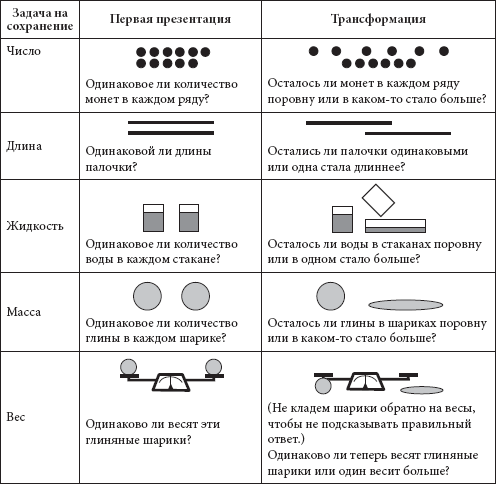
Conservation tasks developed by J. Piaget Source: [Burke, 2006] With the development of thinking, by the age of 7 the child overcomes egocentrism and most other thinking phenomena, moving to the level of logical thinking.
In general, children's thinking is still far from that of an adult, and it can be difficult for a child to figure out what is reality and what is pretense. For example, can witches really cast a spell on you or that a person can grow wings and fly like in a picture in a book.


